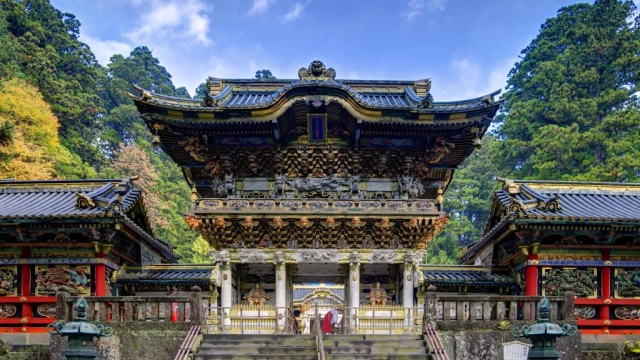Top 10 Must-Visit Shrines in Japan: A Journey Through Spiritual Majesty

Japan is a country steeped in rich traditions and spiritual heritage, making it a unique destination for those seeking both tranquility and enlightenment. Among its many wonders, the shrines stand out as sacred spaces that offer a glimpse into the heart of Japanese culture and spirituality. Each shrine tells a story, reflecting the history, beliefs, and artistry of the people who built and worshipped there. This article takes you on a journey to discover the top ten must-visit shrines in Japan, showcasing their significance and the serenity they provide.
As we explore these remarkable sites, we will delve into the intricate details that make each shrine distinctive. From the iconic torii gates that mark the entrance to sacred grounds, to the beautifully maintained gardens that invite quiet contemplation, these shrines serve as a bridge between the earthly realm and the divine. Whether you are a seasoned traveler or a curious newcomer, this guide to shrine rankings in Japan will help you appreciate the spiritual magnificence that these places embody. Join us as we uncover the essence of these remarkable shrines, inviting you to experience the beauty and peace they offer.
Historical Significance of Japanese Shrines
Japanese shrines, known as "jinja," hold a profound historical significance that dates back to ancient times. They serve as sacred spaces where the kami, or spirits of nature, are worshipped and revered. The origins of these shrines can be traced to Japan’s indigenous Shinto beliefs, blending seamlessly with the country’s rich cultural heritage. This connection to nature and spirituality has made shrines essential in fostering communal identity and continuity, often becoming the focal points of local festivals and rituals.
Over the centuries, many shrines have played pivotal roles in Japan’s history. Some, like Ise Jingu, are considered the most sacred, dedicated to the sun goddess Amaterasu. These shrines have been places of pilgrimage, attracting thousands who seek to connect with their spiritual roots. Additionally, historical events and figures have influenced the establishment and development of many shrines, making them living landmarks of Japan’s past. This intertwining of spirituality and history helps preserve the memories and traditions of bygone eras.
The architectural styles and artistic expressions found within these shrines also contribute to their historical relevance. From the torii gates that mark the entrance to the elegantly designed enclosures, each element reflects various periods of Japanese art and design. Shrines often showcase unique characteristics specific to regional traditions, demonstrating the evolution of Japanese craftsmanship. As such, they offer not only a glimpse into the spiritual life of the Japanese people but also their artistic heritage, making them an integral part of the nation’s history.
Top Shrines to Visit by Region
In the northern region of Japan, Hokkaido is home to the stunning Hokkaido Jingu Shrine. Nestled in a serene forest setting, this shrine is dedicated to the spirits of the region and offers visitors a peaceful retreat. The annual Sapporo Snow Festival nearby attracts many tourists, making it a perfect stop for those exploring the beauty of Hokkaido’s landscapes and cultural heritage.
As we move to the heart of Japan, the Kansai region boasts the renowned Fushimi Inari Taisha in Kyoto. Famous for its thousands of vermilion torii gates winding up to Mount Inari, this shrine is dedicated to Inari, the god of rice and agriculture. The striking visuals and the spiritual ambiance draw millions of visitors each year, making it a must-visit destination for anyone looking to experience Japan’s rich traditions.
Down in the southern region, the historic Kumamoto Prefecture is home to the Suizenji Jojuen Garden, which features the unique Suizenji Jinja Shrine. Surrounded by beautifully manicured gardens that replicate famous scenic spots of Japan, this shrine offers a blend of natural beauty and spiritual experience. Visitors can enjoy a peaceful stroll around the garden while appreciating the deep cultural significance the shrine holds for the locals.
Cultural Practices and Rituals
In Japan, shrines are not just places of worship but are also cultural hubs where traditional practices and rituals are actively upheld. Visitors to these sacred sites often observe Shinto ceremonies that date back centuries, emphasizing a deep connection with nature and the divine. Rituals such as purification or "temizu", where visitors cleanse their hands and mouths at a water basin, symbolize the importance of purity and respect in Shinto beliefs.
Festivals, known as "matsuri", play a significant role in shrine culture, celebrating everything from seasonal changes to agricultural cycles. These vibrant events often feature lively processions, traditional music, and dance, drawing together local communities and visitors alike. Engaging in these celebrations offers insight into the spiritual life of the area, allowing people to experience the joy and reverence that the locals have for their deities and traditions.
Moreover, personal rituals such as offering prayers, tying wishes on ema (wooden plaques), or participating in special ceremonies during the New Year or other significant days serve to strengthen individual connections to the divine. Visitors are encouraged to partake in these practices, reflecting on their own hopes and aspirations, which reinforces the idea that these shrines are not only places of worship but also spaces for personal reflection and growth.
Preserving Spiritual Heritage
The preservation of shrines in Japan is crucial for maintaining the cultural and spiritual identity of the nation. These sacred spaces not only serve as places of worship but also as custodians of history, tradition, and artistry. Many shrines, such as Fushimi Inari Taisha and Meiji Jingu, are meticulously cared for, showcasing the dedication of both local communities and the Japanese government in safeguarding their rich heritage.
Efforts to protect these revered sites include regular restoration initiatives and the implementation of strict regulations regarding construction and alterations in their vicinity. Furthermore, educational programs are increasingly being offered to raise awareness among younger generations about the significance of these sites. By instilling a sense of respect and understanding for their cultural heritage, Japan aims to ensure that future generations will continue to appreciate and cherish these important landmarks.
Additionally, the rise of eco-tourism has played a vital role in promoting the sustainable management of shrines. By encouraging visitors to take part in responsible practices, such as following designated paths and preserving the surrounding nature, shrines can remain vibrant centers of spiritual engagement. As these sacred spaces continue to attract both domestic and international visitors, their preservation becomes integral not only to Japan’s history but also to its ongoing spiritual journey.



